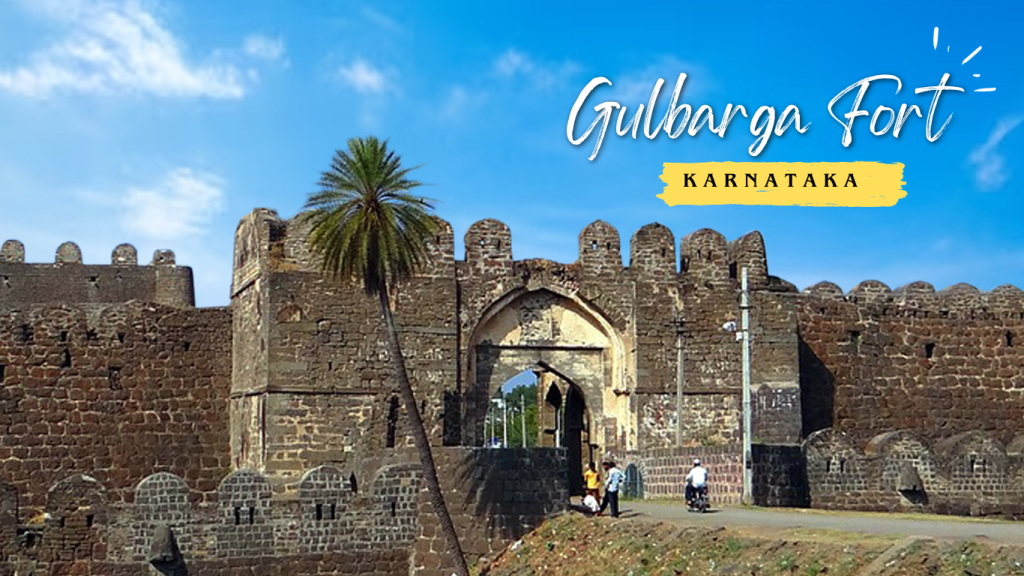Gulbarga Fort Karnataka : A Legacy of Power, Art, and Deccan Spirit (Among the 20 best places to visit in Kalaburagi )

Introduction
Imagine stepping through a doorway in time, where whispers of battles dance on the wind and sun-drenched stones tell tales of kings and empires. Nestled amidst the vibrant Deccan plateau, Gulbarga Fort beckons you on a magical journey, its ancient walls promising adventure at every turn. This isn’t just a pile of bricks and mortar; it’s a living tapestry woven with threads of history, art, and the enduring spirit of India.
From Humble Start to Sultan’s Playground:
Before it became the magnificent fortress we see today, (Gulbarga also called kalaburagi) Gulbarga started humbly as a small outpost under Raja Gulchand. But in the 14th century, it entered a new chapter with the arrival of Sultan Hasan Bahmani. A visionary leader, Bahmani saw Gulbarga’s potential and dreamt of transforming it into a symbol of his Deccan Sultanate’s power. Thus began a grand transformation, a metamorphosis from a modest fort to a formidable stronghold. Walls fortified with 15 towering bastions (think giant guards!) and a double layer of protection rose around the city, making it nearly impregnable.
Sun-Kissed Art and Whispers of Prayer:
Step inside these fortified walls, and a symphony of grandeur awaits. Mosques, palaces, and tombs stand tall, each adorned with intricate carvings and vibrant patterns. Imagine Persian influences merging with local Deccan traditions, creating a unique artistic style that’s both elegant and breathtaking.
The Jami Masjid is the crown jewel of this architectural feast. Built in 1367, it stands unlike any other mosque in India. Picture a prayer hall completely enclosed, a serene haven woven from sunlight and stone. Light dances on the walls, painting delicate calligraphy with its touch, while whispers of ancient prayers seem to brush past you like gentle waves. Geometric patterns on the ceiling shimmer like a million stars, reminding you of the faith and devotion that once resonated within these walls.
Boom! Meet the World’s Biggest Cannon:
Gulbarga isn’t just about quiet whispers and artistic marvels. It also boasts a loud and proud side, thanks to the Bara Gazi Toph, the world’s longest cannon! Imagine a giant metal beast, 29 feet long and heavy enough to make even elephants nervous! This wasn’t just a weapon; it was a powerful symbol of the Bahmani Sultanate’s might. Every time it roared, the earth trembled, sending enemies scurrying faster than gazelles on Red Bull!
Beyond the Walls: A Symphony of Life
The magic of Gulbarga extends beyond its fortified walls. Venture into the bustling Deccan region, where markets burst with the vibrant colors of spices and the aroma of delicious local cuisine. Watch skilled artisans transform wood and cloth into works of art, their nimble hands weaving magic before your eyes. Let the rhythm of traditional music wash over you, each note a vibrant thread in the tapestry of Deccan culture. It’s a sensory feast you won’t soon forget!
Important Places Within the Gulbarga Fort:
- Fateh Darwa and Jama Masjid Darwa: These majestic gateways, adorned with intricate carvings, welcome you into the fort’s past.
- Bandakhana Bastion: Climb this former ammunition storehouse and soak in panoramic views, once strategic vantage points for the fort’s defenders.
- Jama Masjid Garden: Find solace in this serene haven amidst the fort’s grandeur, where fragrant flowers and gentle fountains offer a moment of respite.
- Hazrat Bande Nawaz Dargah: Pay your respects at the tomb of this revered Sufi saint, whose teachings continue to inspire many.
Reaching Gulbarga Fort ( Kalaburagi ):
Getting to Gulbarga Fort is easier than ever, with convenient connections by road, rail, and air
- By Road: Several state and national highways connect Gulbarga to major cities like Bangalore, Hyderabad, and Mumbai.
- By Rail: Gulbarga Railway Station is well-connected to various cities across India.
- By Air: kalaburagi airport
Canclusion
Gulbarga Fort is more than just a fort; it’s a living, breathing storybook. It’s a place where whispers of warriors mingle with the vibrant pulse of the Deccan region. It’s a place where you can explore hidden secrets, discover the art of ancient kings, and feel the magic of time come alive. So pack your curiosity, put on your walking shoes, and get ready to be swept away on a journey you’ll never forget. The world of Gulbarga awaits, eager to share its whispers and enchant you with its timeless beauty. for more information on gulbarga (kalaburagi) click here